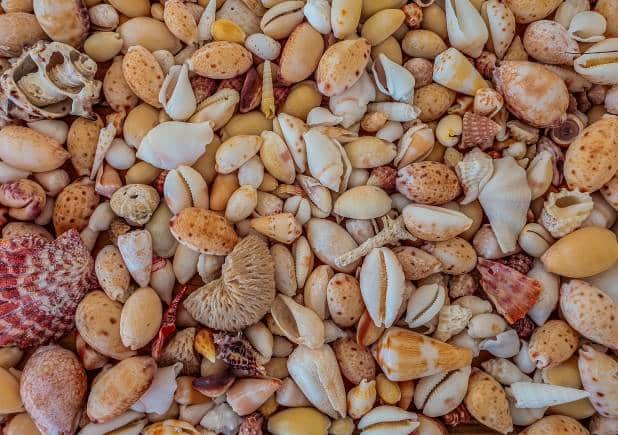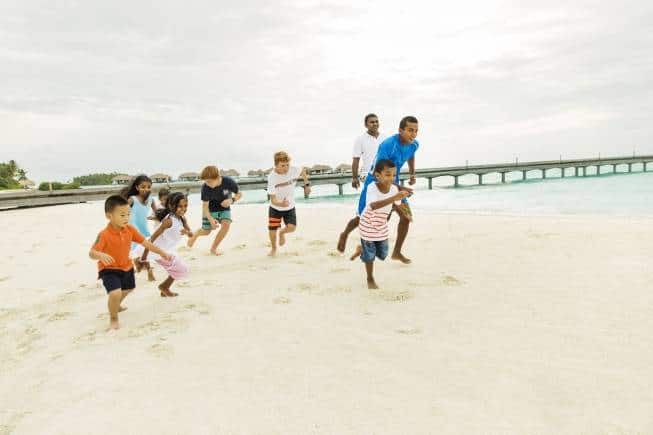



Maldivian waters beckon, even before you set foot on the island-nation. Glimpse the nation, from up in the air, and you’ll see clear, placid waters, warmed by the rays of the sun. These waters hold many a treasure. Even if you’re a timid swimmer, you can still take in what lies beneath. Because the sea regularly spills her secrets - weird and wonderful shells from her very depths, dot the sandy shores. Seashells are used in everything from construction materials (as a replacement for concrete, where suitable), to toothpaste, due to the fact that shat shells contain calcium carbonate. However, it is illegal to carry back seashells from Maldives. So, admire the beauty around in the moment only.
Don’t know your conch shells from your cowries? We got you sorted. We got the experts to shell-all. From the best time to search for shells, to quirky facts on these biological treasures, this comprehensive guide has it all.
Shells are everywhere. So, why Maldives?
Because it’s illegal to bring back seashells from Maldives. Fret not, we aren’t asking you to defy the rules. On the contrary, we want you to obey them, and bring back only vivid memories. After all, isn’t a holiday about taking a break from chasing the material; a break from the desire to own and accumulate. On this little adventure, you simply enjoy the moment, in the here and now.
I started my shelling adventure at Sun Siyam Iru Veli, a property that sits on ribbons of white sands, overlooking the deep blue. The property comes with villas that open up into the waters (a stairway has you plunge from your deck, into the big blue), or villas that open up to the sandy beach. Time stands still when you’re here, enveloped in nature. Yet, I’ll admit that as I started out on my shell-walk, the ingrained ‘productivity culture’ initially led me to lose the beauty of the moment. But then, I tuned into the feeling of the powder-white sands beneath my feet; tuned into the sound of the ocean, and let it wash away all thoughts. Almost on cue, the waves washed ashore some fabulous, colourful shells. The trick: let the shells find you.
Maldivian history in a seashell
Maldivian history is written in a shell. The cowrie shell, to be precise. Ask a local, and you’ll hear the history in an animated, delightful manner. “We were once the mint of the World,” says Hassoon Abdul Wahidh, manager, Sun Siyam Iru Veli resort. He reveals that the cowrie was once used as currency across the globe, and, therefore, is aptly named ‘money cowrie’.
One look at the money cowrie and you’ll know exactly why it was chosen as currency. It’s small enough to pack into your pocket, shiny enough to look like currency, and they jingle in your pocket, much like coins.
 Cowrie shells were once used as currency across the globe. (Photo: Nattu Adnan via Unsplash)
Cowrie shells were once used as currency across the globe. (Photo: Nattu Adnan via Unsplash)
Their size and durability made them a chosen form of currency across the globe. At different points in time, cowries were used as currency in India, China, and Africa. Maldives - blessed with an abundance of cowrie shells - minted money, literally and figuratively, as the island-nation supplied these shells to the rest of the World. Long before tourism, it was this shiny little shell that put Maldives on the global map.
What exactly are seashells?
 Seashells are made by sea-creatures known as mollusks. (Photo: Ivan via Unsplash)
Seashells are made by sea-creatures known as mollusks. (Photo: Ivan via Unsplash)
Seashells are made by sea-creatures known as mollusks. There are 85,000 known species of mollusks in the world. Among the better known ones are snails, clams, mussels, etc. These mollusks have an outermost layer of tissue in their body known as the mantle. Specialised cells in the mantle create the shell that serves to protect the mollusks. Mollusks never shed their shells. In fact the shell grows with the creature, to encase and protect it from predators. When mollusks die, they leave the shells behind - much like humans leave behind skeletons.
The best time to chance upon them
 There are 85,000 known species of mollusks in the world. And the right time to look for seashells is right after a low tide. (Photo via Wikimedia Commons)
There are 85,000 known species of mollusks in the world. And the right time to look for seashells is right after a low tide. (Photo via Wikimedia Commons)
Danielle Stanley, marine biologist, Outrigger Maldives Maafushivaru resort says, “The best time to search for seashells is right after the low tide (about an hour or so). The changing tides are what brings the shells up to the beach, from relatively deeper water. At lower tides, there is also more space on the beach, so more surface area to look out for shells.”
Outrigger comes with all the trappings of luxury - villas in the midst of waters, standing on stilts, beach side villas with private pools, an in-house spa, water sports, etc. But it’s the presence of an approachable, in-house marine biologist that makes the stay even more special.
Danielle adds to the adventure by directing me to the beaches on the east side of the property. She says, “Here the sand meets the shallows due to a man-made barrier (to stop storm surges).
This means the water is usually warm, especially at low tides. Even if you are not a swimmer, you can walk through the shallows and see some blacktip reef sharks, and more. There is also some coral life growing on this man-made barrier so you can wade in the water and have a look without having to swim.”
What shells can one find in the Maldives?
 There are several different types of shells you can find in Maldives. (Photo: Lidia Stawinska via Unsplash)
There are several different types of shells you can find in Maldives. (Photo: Lidia Stawinska via Unsplash)
There are several different types of shells you can find in Maldives. Apart from the cowries, you could chance upon the triton shell - the gorgeous beauty that resembles a trumpet. Beware though, since legend has it that these shells come with magical properties that bestow luck (good or bad!) upon the one who spots them.
You could also chance upon the spider conch shell which is rather dramatic looking, with a spiky spine and hints of brown or black fleckles. Or the moon shells, (once the outer covering of the moon snail), that looks smooth, shiny and spotted in a variety of colours from cream to brown. Or the olive shells, (once the outer covering of the olive snail), that are smooth, oval in shape, with brown and black streaks and freckles. And many more.
If you’re lucky, you’ll come across a brightly coloured shell that makes for a dramatic picture imprinted in your memory.
No gear, no fear
 Let the seashells of Maldives find you. (Image courtesy COMO Maalifushi)
Let the seashells of Maldives find you. (Image courtesy COMO Maalifushi)
One doesn't really need any special gears for the shells. A scoop, however, could come in handy to avoid the occasional gecko or crab.
Photographs only
 Marine life of Maldives. (Photo: Ahmed Nishaath via Unsplash)
Marine life of Maldives. (Photo: Ahmed Nishaath via Unsplash)
“I believe it’s okay to take a picture if the shell has been washed up on the shoreline, and can no longer be a home for any marine critter. Yet, it’s important to place the shell back in its place after photos,” says Danielle, warning, “A severe depletion of shells will lead to changes in the rates and patterns of erosion along the shoreline.”
Don’t pocket the shells. It’s illegal. Return them to nature. Danielle says, “Although the ‘animal’ that once lived inside the shell may no longer be alive, the shell’s cycle is still useful in the ocean in many different ways. Shells protect the beaches from further erosion.”
Discover the latest Business News, Sensex, and Nifty updates. Obtain Personal Finance insights, tax queries, and expert opinions on Moneycontrol or download the Moneycontrol App to stay updated!
Find the best of Al News in one place, specially curated for you every weekend.
Stay on top of the latest tech trends and biggest startup news.